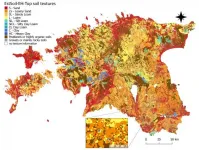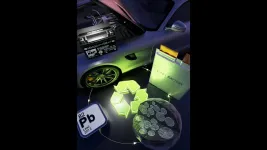New dataset opens Estonian soil information for versatile use
2021-02-16
(Press-News.org) A comprehensive database of Estonian soils and a map application has been completed in cooperation with researchers of the University of Tartu and the Estonian University of Life Sciences. The database makes Estonian soil information easily accessible and can be used from local farm-scale to national-level big data statistical analysis and machine-learning models.
"Soil data is possibly the most undervalued and yet complicated type of environmental data there is. The diversity of organic, chemical, living and dead materials that make up a handful of dirt is astounding," said Alexander Kmoch, Research Fellow in Geoinformatics at the University of Tartu and the leading author of the study.
Estonia has had very detailed soil information available for decades. It is digitally available on the Geoportal of the Estonian Land Board in several formats under a permissive open data license. Its main purposes include land evaluation and assessing potential for agricultural use.
Unfortunately, it was not easy to make much use of the data so far. One of the reasons that limited the wider use of the soil map was the way the data was structured in the database. "For each soil unit, a series of complicated text codes and numbers describe very specialized soil type and soil texture, organic layer, rock content, and the potential for agricultural use. Only few experts can interpret that on a field-by-field basis, but it was close to impossible to derive large-scale actionable insights," said Kmoch.
Researchers of the University of Tartu and the Estonian University of Life Sciences have undertaken the mammoth project of deciphering that information and providing it in an easily readable table-based form, with all the bits and pieces extracted into numbers and categories that are much easier to analyze and use in a variety of use cases.
The new dataset is called EstSoil-EH, the Estonian soil dataset with ecological and hydrological variables all derived from the original soil map of Estonia. In addition, the new dataset is enriched with area and percentage information on six simple land-use types: arable, grassland, forest, wetland, urban/buildup and water. One can also find topographical variables like slope per each distinct soil unit.
Furthermore, machine learning was used to complement the new dataset with the soil organic carbon estimates. This way it opens Estonian soil information to many new specialized use cases from digital agriculture support to forest management, environmental assessments, biodiversity restoration, eco-tourism and much more.
"Countries like Lithuania and Latvia may have similar historical soil records from the Soviet era that could be turned into value-added datasets by using the same methodology," said Kmoch.
INFORMATION:
A scientific peer-reviewed article describing the data processing and validation in detail was published in the journal Earth System Science Data.
Explore the soil of Estonia interactively: https://estsoil-eh.web.app/
The new EstSoil-EH dataset is available as open data: https://doi.org/10.5281/zenodo.3473289
[Attachments] See images for this press release:

ELSE PRESS RELEASES FROM THIS DATE:
2021-02-16
BINGHAMTON, NY -- Rich nations should not engage in "vaccine nationalism" and keep the COVID-19 vaccine to themselves when poorer nations need them, according to Nicole Hassoun, professor of philosophy at Binghamton University, State University of New York. Hassoun's paper, "Against Vaccine Nationalism," was published in the Journal of Medical Ethics.
While rich countries like the US and UK are starting to vaccinate their populations against COVID-19, poor countries may lack access to a vaccine for years. Canada, for instance, has already secured enough to vaccinate its entire population nine times over, and the US, European Union, UK, Australia, and Japan can vaccinate their populations between 2-8x.
"Vaccine nationalism ...
2021-02-16
Globalization, digitalization, sustainabilization - three major waves of transformation are unfolding around the world. The social upheaval caused by these transformation processes has given rise to populist movements that endanger social harmony and threaten democratic values. What rules and institutions can promote stability in the face of such systemic risks? A new study published by the Institute for Advanced Sustainability Studies (IASS) offers some surprising answers.
The coronavirus pandemic has demonstrated for the first time how a systemic risk can sweep across our globalized world. It began with the little-noticed outbreak of an unknown ...
2021-02-16
The lithium-ion battery powers everything from mobile phones to laptops to electric vehicles. Scientists worldwide are always on the hunt for new and improved components to build better batteries for these and other applications.
Scientists from the U.S. Department of Energy's (DOE) Argonne National Laboratory report a new electrode design for the lithium-ion battery using the low-cost materials lead as well as carbon. Contributors to this pivotal discovery also include scientists from Northwestern University, Brookhaven National Laboratory and the Ulsan National Institute of Science and Technology (UNIST).
"Our new anode could offer a new revenue stream for the large industry currently engaged in lead-acid battery ...
2021-02-16
By Maria Fernanda Ziegler | Agência FAPESP – The use of cover crops between cotton harvests protects the soil, conserves water, and reduces the risk of erosion. Researchers at the University of Western São Paulo (UNOESTE) and São Paulo State University (UNESP) in Brazil found that application of potassium (K) to a grass cover crop grown before cotton in sandy soil lowered production cost and resulted in cotton with a higher market value.
“The dynamics of early application of potassium to grass planted as a cover crop before cotton ...
2021-02-16
Crocodiles are resilient animals from a lineage that has survived for over 200 million years. Skilled swimmers, crocodiles can travel long distances and live in freshwater to marine environments. But they can't roam far overland. American crocodiles (Crocodylus acutus) are found in the Caribbean and Pacific coasts of the Neotropics but they arrived in the Pacific before Panama existed, according to researchers from McGill University.
Over 3 million years ago, the formation of the Isthmus of Panama altered global ocean circulation, connecting North and South America and establishing the Caribbean Sea. This resulted in widespread mixing of species ...
2021-02-16
Scientists at the Center for Infection and Immunity (CII) at Columbia University Mailman School of Public Health and SunYat-Sen University in China have set the stage for the development of highly sensitive antibody tests for infection with all known human coronaviruses, including new variants of SARS-CoV-2. These tests should also allow differentiation of immune responses due to infection and vaccination. The research is published in Communications Biology, a Nature journal.
The HCoV-Peptide array developed by CII scientists consists of 3 million immune markers on a glass chip, ...
2021-02-16
INDIANAPOLIS--Researchers from Indiana University have identified key genetic changes in the interstitial kidney tissue of people with diabetes, a discovery that signifies the potential for a revolutionary new genetic approach to the treatment of kidney disease. They will contribute their findings to the Kidney Precision Medicine Project's (KPMP) "cell atlas," a set of maps used to classify and locate different cell types and structures within the kidney.
They shared their groundbreaking findings in a study published on February 10, 2021, in Science Advances.
In the study, researchers investigated the kidney tissue of healthy people and people with diabetes using a technique called "regional transcriptomics." This technique involves a rapid ...
2021-02-16
The COVID-19 infection rate among pregnant women was estimated to be 70% higher than in similarly aged adults in Washington state, according to a new study published today in American Journal of Obstetrics and Gynecology. Other key findings include:
The study also showed that the number of COVID-19 infections in pregnant patients from nearly all communities of color in Washington was high. There was a twofold to fourfold higher prevalence of pregnant patients with COVID-19 infections from communities of color than expected based on the race-ethnicity distribution of pregnant women in Washington in 2018.
A high number of pregnant women with COVID-19 received ...
2021-02-16
Leukemia is caused by leukemic stem cells which are resistant to most known therapies. Relapses are also due to this resistance. Leukemic stem cells arise from normal blood-forming (hematopoietic) stem cells. Because they are closely related, leukemic and hematopoietic stem cells share many of the same signaling pathways. If the proliferation of leukemic stem cells is to be stopped, it is crucial to find signaling pathways that are active only in the leukemic stem cell, but not the normal one. With this goal in mind, Prof. Adrian Ochsenbein and his team are conducting research at the Department ...
2021-02-16
Our universe is dominated by a mysterious matter known as dark matter. Its name comes from the fact that dark matter does not absorb, reflect or emit electromagnetic radiation, making it difficult to detect.
Now, a team of researchers has investigated the strength of dark matter scattered across the smallest galaxies in the universe using stellar kinematics.
"We discovered that the strength of dark matter is quite small, suggesting that dark matter does not easily scatter together," said professor Kohei Hayashi, lead author of the study.
Much is unknown about dark matter, but theoretical and experimental research, from particle physics to astronomy, are elucidating more ...
LAST 30 PRESS RELEASES:
[Press-News.org] New dataset opens Estonian soil information for versatile use






